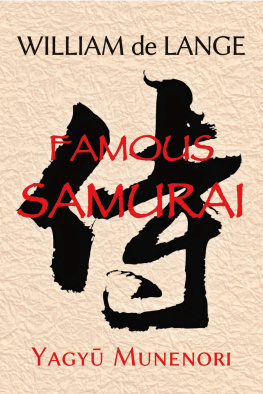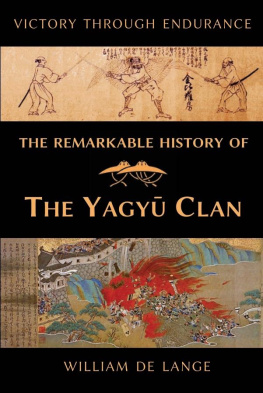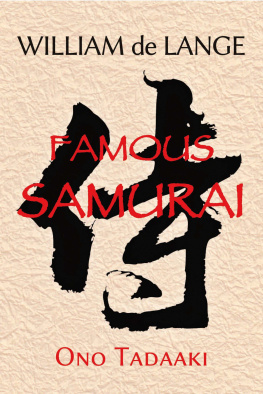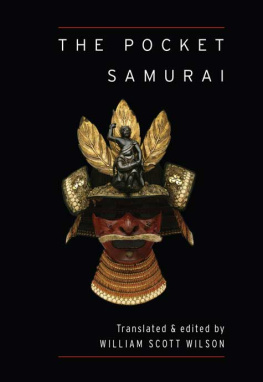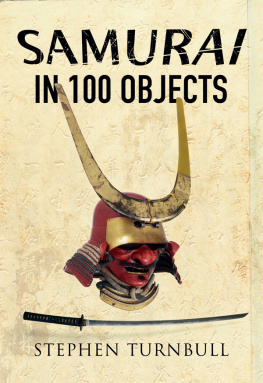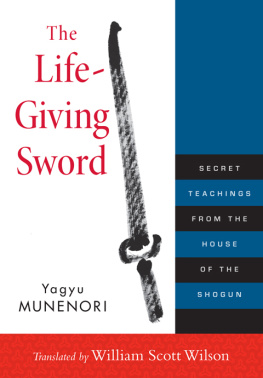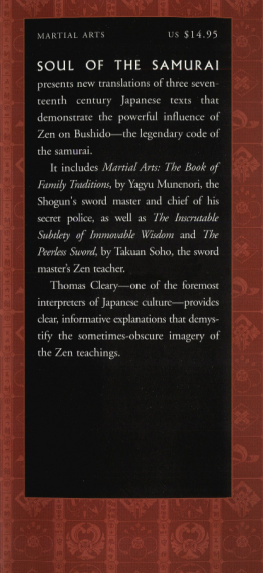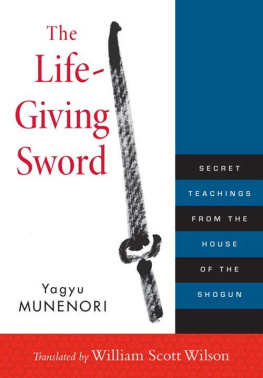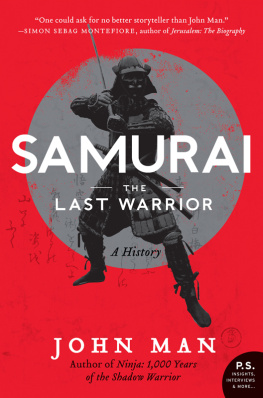William de Lange - Famous Samurai: Yagyu Munenori
Here you can read online William de Lange - Famous Samurai: Yagyu Munenori full text of the book (entire story) in english for free. Download pdf and epub, get meaning, cover and reviews about this ebook. year: 2008, publisher: Floating World Eds., genre: Detective and thriller. Description of the work, (preface) as well as reviews are available. Best literature library LitArk.com created for fans of good reading and offers a wide selection of genres:
Romance novel
Science fiction
Adventure
Detective
Science
History
Home and family
Prose
Art
Politics
Computer
Non-fiction
Religion
Business
Children
Humor
Choose a favorite category and find really read worthwhile books. Enjoy immersion in the world of imagination, feel the emotions of the characters or learn something new for yourself, make an fascinating discovery.
- Book:Famous Samurai: Yagyu Munenori
- Author:
- Publisher:Floating World Eds.
- Genre:
- Year:2008
- Rating:5 / 5
- Favourites:Add to favourites
- Your mark:
- 100
- 1
- 2
- 3
- 4
- 5
Famous Samurai: Yagyu Munenori: summary, description and annotation
We offer to read an annotation, description, summary or preface (depends on what the author of the book "Famous Samurai: Yagyu Munenori" wrote himself). If you haven't found the necessary information about the book — write in the comments, we will try to find it.
Famous Samurai: Yagyu Munenori — read online for free the complete book (whole text) full work
Below is the text of the book, divided by pages. System saving the place of the last page read, allows you to conveniently read the book "Famous Samurai: Yagyu Munenori" online for free, without having to search again every time where you left off. Put a bookmark, and you can go to the page where you finished reading at any time.
Font size:
Interval:
Bookmark:
WILLIAM de LANGE

Yagy Munenori

FLOATING WORLD EDITIONS
Published by Floating World Editions, Inc.
26 Jack Corner Road, Warren, CT 06777
www.oatingworldeditions.com
Floating World Editions publishes books that contribute to a deeper understanding of Asian cultures. Editorial supervision: Ray Furse.
Previously published in:
Famous Japanese Swordsmen: The Period of Unification
Copyright 2008 by William de Lange.
First print edition, copyright 2008
First digital edition, copyright 2012
Protected by copyright under the terms of the International Copyright Union; all rights reserved. Except for fair use in book reviews, no part of this book may be reproduced for any reason by any means, including any method of digital reproduction, without the permission of the publisher.
ISBN 978-1-891640-67-4
Iaid
Through the Eye of the Needle
A History of Japanese Journalism
A Dictionary of Japanese Idioms
A Dictionary of Japanese Proverbs
The Real Musashi, Origins of a Legend I: The Bush denraiki
The Real Musashi, Origins of a Legend II: The Bukden
Miyamoto Musashi: A Life in Arms

Yagy Munenori was born in 1571. He had four older brothersYoshikatsu, Yoshihide, Munetaka, and Muneaki. Being the youngest, Munenori was destined to spend his early youth in relative idleness, practicing the art of fencing with his brothers and making votive offerings at the local shrine for the repose of his ancestors souls. To the clan, however, the birth of another boy was the symbol of renewed hope, for the Yagy at this time were struggling hard to recover from a string of misfortunes.
Those misfortunes had begun in 1544, when the Yagy domains were overrun by the Tsutsui, a clan from the Nara basin. Munenoris father, Muneyoshi, had fiercely resisted their expansion, but paid for his bravery with the loss of Yagy castle. Eventually he submitted and set about to rebuild the stronghold.
Sixteen years later, the world of the Yagy had been turned upside down again. The year was 1560, when the Tsutsui were subdued by the Miyoshi, who hailed from the province of Awa on the island of Shikoku. Again the Yagy were forced to adjust to a new overlord, the inuential Miyoshi Chkei, in order to survive.

Miyoshi Chkei, a shrewd and able administrator
While a warlord in the typical mold of his time, Chkei was an upright man, widely respected for his administrative talents, and for a while the Yagy accepted their fate with resignation. This changed in 1564, when Miyoshi Chkei was succeeded by Matsunaga Hisahide, a one-time tea merchant from Kyoto, who had insinuated himself into the position of Chkeis senior counselor and succeeded him by poisoning his rightful heir.
So, at least, went the rumorsrumors that were readily accepted as fact when, within only a year of his succession as chieftain, Hisahide had the thirteenth shogun of the Muromachi Bakufu, Ashikaga Yoshiteru, assassinated, along with his wife and mother. That assassination had forced Yoshiterus younger brother, Yoshiaki, to fall back on the military clout of Oda Nobunaga, giving the latter, in turn, a pretext to seize the capital.
For the Yagy clan Nobunagas arrival in the capital was welcome news. With each year Hisahides behavior had become more erratic. At rst he had been kept in check by his brother, Nagayori, the vice-governor of Tanba province. In every way the opposite of his brother, Nagayori was a warrior of great moral stature, who was respected by the Miyoshi clan. Indeed, it was more out of respect for his brother than for any of his qualities that the Miyoshi had acquiesced in Hisahides chieftaincy.
Thus it came as no surprise to the Yagy that, when Nagayori died in battle in 1565, the majority of the Miyoshi clan fell out with their new leader and launched a large-scale campaign to recapture the strongholds that he had subdued on their behalf a few years earlier.
The rst castle to fall into their hands was that of Tsutsui, at the heart of the Nara basin, the clans traditional power base. Over the next year the ghting spread eastward, toward Nara and Hisahides headquarters of Tamon castle. The castle stood at a stones throw from the famous Daibutsuden, the great hall on the premises of the Tdai monastery. For more than eight centuries the wooden structure had housed a forty-eight-foot-tall bronze Buddha that attracted pilgrims from the far corners of the country. Part of the Miyoshi troops had taken up quarters in and around the premises of the venerated building.
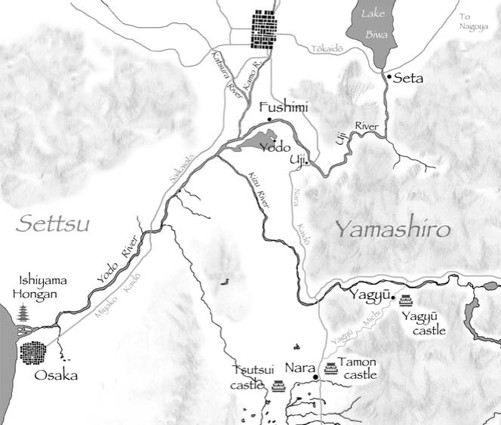
Untrammelled by conscience, Hisahide had ordered his men to open re on the building. The Miyoshi troops were scarcely harmed, but the roof of the building went up in ames, causing the top part of the statue to melt away. The string of depredations by their new overlord eventually forced Yagy Muneyoshi and his clan to go into hiding among the mountains.
Little did Muneyoshi know at the time that it would be their period in isolation that was to lay the foundation for his clans remarkable recovery. For when the Yagy went into hiding, they did so in the company of none other that Kamiizumi Ise no Kami Nobutsuna, founder of the famous Shinkage school of fencing.
Kamiizumi Nobutsuna had arrived in Yamato in the fall of 1567. He had been on a musha shugy , in the company of two other swordsmen, Jingo Muneharu and Hikida Bungor, two trusted vassals with whom he had survived the siege of Minowa castle. He and the Yagy chieftain had met at a fencing contest at the Kfuku monastery.
The contest had been organized by Hzin Kakuzenb Inei, chief abbot of the Kfuku monastery and founder of the Hzin school of spear ghting. Inei introduced the two swordsmen. Muneyoshi had engaged in a tary shiai with both Nobutsuna and his pupil Bungor. Muneyoshi had lost both contests, but had been wise enough to invited the three swordsmen to come and stay at Yagy castle.
Over the next years they had immersed themselves in their studies, Nobutsuna writing long tracts on the Shinkage-ry, Muneyoshi absorbing from his newfound teacher all that he could about this new and exhilarating school of fencing. Meanwhile they anxiously followed events, pinning their hopes on the day when forces larger than they could ever hope to muster would turn things in their favor and enable them to reemerge from their self-imposed exile. That day arrived on November 9, 1568, when Oda Nobunaga entered Kyoto in full panoply.
Nobunaga had closely followed the actions of Yamatos warlords, even before marching on the capital. He had denounced their senseless bellicosity, yet he was most critical of Hisahide.
Discussing the matter with his ally Ieyasu, Nobunaga had observed that Hisahide was a man of whom they should be extremely wary, as he had gained notoriety in this world for three crimes. The rst was the assassination of the rightful Miyoshi heir. The second the assassination of the shogun. The third the destruction of the Great Buddha of the Tdai monastery. Such men belonged to a bygone era, an era in which the guiding principle in life was the dictum of gekokuj the world turned upside downan inverted social order in which the lowly came to reign over the elite through sheer talent and cunning .
Font size:
Interval:
Bookmark:
Similar books «Famous Samurai: Yagyu Munenori»
Look at similar books to Famous Samurai: Yagyu Munenori. We have selected literature similar in name and meaning in the hope of providing readers with more options to find new, interesting, not yet read works.
Discussion, reviews of the book Famous Samurai: Yagyu Munenori and just readers' own opinions. Leave your comments, write what you think about the work, its meaning or the main characters. Specify what exactly you liked and what you didn't like, and why you think so.

